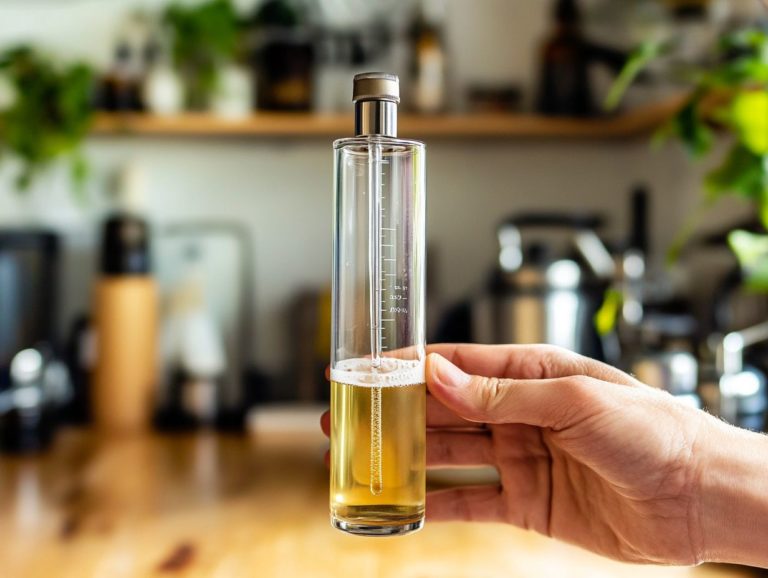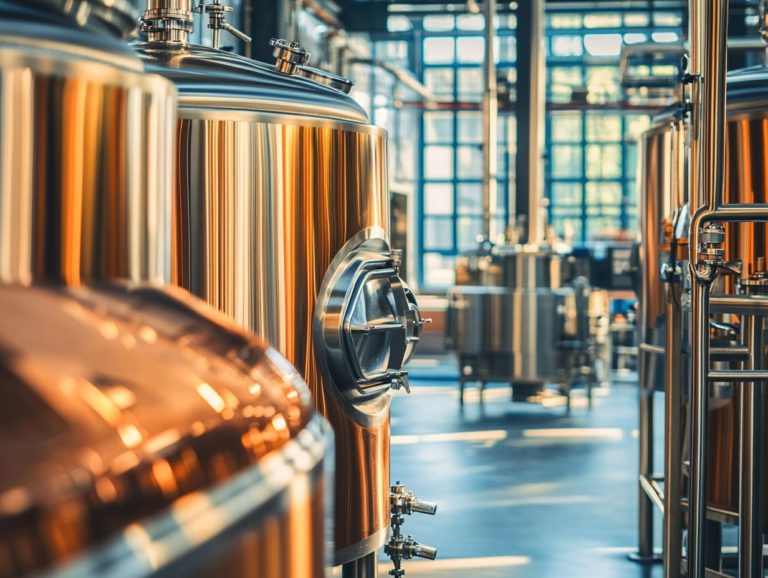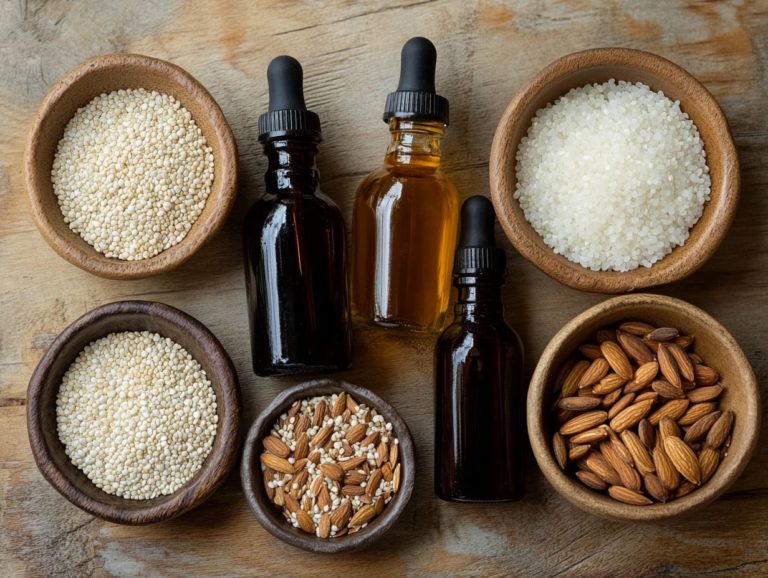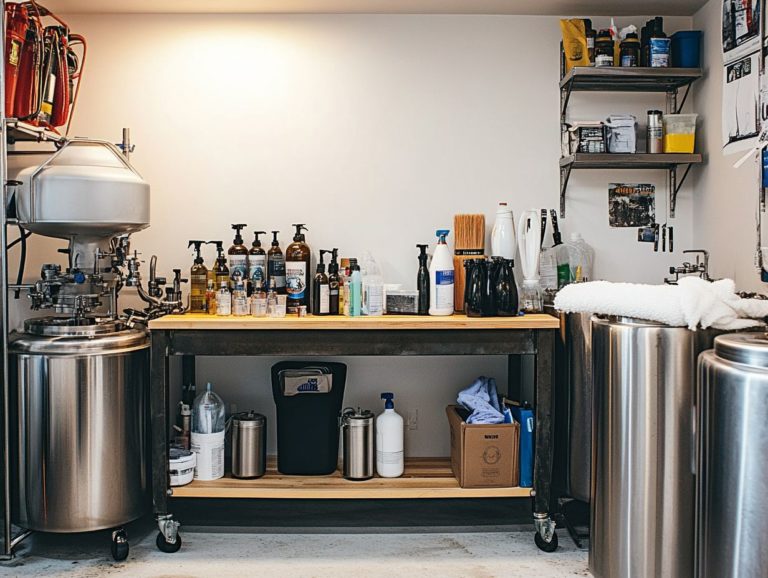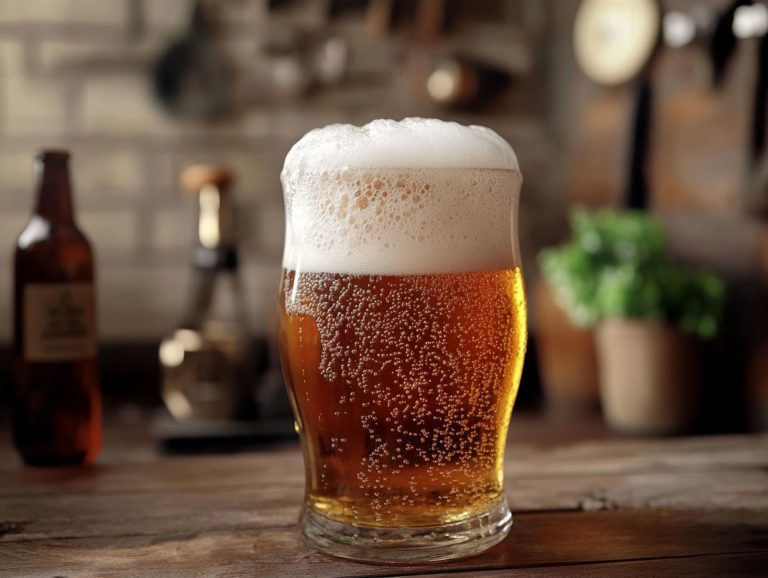What Should I Do If My Beer Tastes Bad?
Ever wondered what went wrong when your beer tastes off? You re certainly not alone.
The reality is that a subpar beer can stem from a variety of issues, including inadequate sanitation, spoiled ingredients, or simple brewing blunders.
In this article, you ll delve into the common culprits behind off-flavors, discover how to remedy your brew, and glean valuable tips to prevent future missteps. Say farewell to the days of bad beer it’s time for a flavorful transformation!
Contents
- Key Takeaways:
- Why Does My Beer Taste Bad?
- How Can I Fix My Bad Tasting Beer?
- Is It Safe to Drink Bad-Tasting Beer?
- How Can I Prevent My Beer from Tasting Bad in the Future?
- When to Seek Help with Bad Tasting Beer
- Frequently Asked Questions
- What Should I Do If My Beer Tastes Bad or Shows Skunky Aromas?
- What is the Best Way to Store Beer to Avoid Skunking?
- How Can I Tell If My Beer is Contaminated or Infected?
- What Should I Do If My Beer Has Expired or Tastes Stale?
- Can I Fix a Bad-Tasting or Green Beer?
- What Should I Do If I Bought a Bad Batch of Beer, Like Bud/Miller/Coors?
Key Takeaways:

- Identify the cause of the bad taste and adjust the recipe or re-brew the beer to fix the issue.
- Check for signs of spoilage before deciding to drink bad tasting beer.
- To prevent bad tasting beer in the future, prioritize proper sanitation, fresh ingredients, careful following of brewing instructions, and the use of UV-filtering brown glass.
Why Does My Beer Taste Bad?
When indulging in craft beer, few experiences are as disheartening as encountering an unpleasant flavor in your brew. Numerous factors can lead to this unfortunate outcome, such as inadequate sanitation practices during the brewing process or those infamous skunky aromas that emerge from lightstruck beer.
Brewing mishaps, the use of spoiled ingredients, and various contamination issues can all leave your beer tasting less than ideal. This sometimes results in skunky aromas or even the formation of diacetyl, a buttery-tasting compound. Grasping these elements is crucial for any discerning beer enthusiast who seeks to relish the rich tapestry of flavors across different beer styles while steering clear of the pitfalls of faulty brews.
1. Poor Sanitation
Poor sanitation is one of the primary culprits behind that less-than-appealing taste in craft beer. When you overlook proper hygiene practices during fermentation and handling, you open the door to wild yeast and bacteria wreaking havoc on your batches.
The result? Infected beer, often showcasing off-flavors that no one wants to sip. This highlights just how crucial cleanliness is in ensuring your equipment and brewing environments remain free from unwanted substances.
Contaminants can easily infiltrate the brewing process through poorly cleaned kettles, fermenters, or even packaging materials. When this happens, you could end up with some truly undesirable flavors, like the sour tang from certain bacteria or the vinegar-like kick from certain infections.
Imagine discovering that your otherwise flawless IPA now carries a funky note reminiscent of spoiled fruit or a green apple flavor caused by acetaldehyde suddenly, the integrity of your entire batch is at stake. Thus, maintaining rigorous sanitation standards is not just important; it s essential for delivering exceptional and consistent brews that keep your customers coming back for more.
2. Spoiled Ingredients
The quality of the ingredients you choose for craft beer brewing is crucial to the final taste of your product; spoiled ingredients can spoil even the best recipes. When hops are stale or malt is improperly stored, you might inadvertently create beer with undesirable flavors, like skunky aromas or a disappointing lack of the expected hoppy character.
To ensure you have the freshest ingredients, always check the packaging dates and steer clear of anything that appears discolored, improperly sealed, or has been exposed to UV light. For example, hops can lose their aromatic oils when exposed to light or air for too long, dulling those vibrant flavors you re aiming for.
Similarly, malt can develop a musty taste if it isn’t stored in a cool, dry place, potentially introducing off-flavors that could ruin your carefully crafted brew. Understanding how to properly select and store your ingredients is vital for preserving the integrity of the flavors you strive to achieve in your brewing endeavors.
We would love to hear your experiences or tips on brewing better beer!
3. Common Brewing Mistakes
Brewing mistakes can lead to a range of unpleasant flavors in craft beer, often rooted in mismanagement during the brewing process. One common misstep is the formation of diacetyl, a buttery-tasting compound that can entirely ruin the drinking experience and is sometimes linked to a condition known as popcorn lung. Similarly, acetaldehyde can impart a green apple flavor that is equally unappealing.
Improper temperature control at various stages of brewing can produce unwanted esters (fruity flavors) and phenols (spicy flavors), overwhelming the intended flavor profile. Over-oxygenation is another trap to avoid, as it can result in stale or cardboard-like flavors that detract from the beer s freshness. Incorrect fermentation timing can cause the yeast to generate excess byproducts, contributing to off-flavors.
To steer clear of these pitfalls, you must monitor temperatures closely, maintain proper oxygen levels, and stay vigilant about fermentation schedules. This approach allows the yeast to work its magic without venturing into undesirable realms.
4. Contamination in Brewing
Contamination is a crucial factor that can truly spoil the exquisite taste of craft beer, often stemming from inadequate sanitation or the unwelcome intrusion of wild yeast. This can result in infected beer, unleashing a cacophony of unexpected flavors from sour tangs to off-putting aromas that overshadow the intended profile, often associated with wild yeast contamination.
A variety of microorganisms, including bacteria and wild yeasts like Brettanomyces, can infiltrate your brewing process. While these flavors may be desirable in certain styles, they’re generally unwelcome in classic brews. For instance, lactic acid bacteria can introduce a tangy sourness, whereas specific yeast strains might impart funky or earthy characteristics.
You must ensure the quality of your beer! Start by following stringent sanitation protocols. This means meticulously cleaning your equipment and utilizing sanitized water. Closely monitoring fermentation conditions allows you to catch any signs of unwanted microbial activity early in the process, safeguarding the delightful experience your craft beer is meant to deliver.
How Can I Fix My Bad Tasting Beer?

If you ve ever found yourself faced with the unfortunate experience of bad-tasting craft beer, rest assured there are effective steps you can take to rectify the situation and elevate the quality of your brew.
Begin by pinpointing the root cause of the undesirable flavor. This could stem from issues such as inadequate sanitation, compromised ingredients, or errors made during the brewing process. Once you’ve identified the source, you can thoughtfully consider making adjustments to your recipe and perhaps even re-brewing the beer to craft a more enjoyable and refined version.
1. Identify the Cause of the Bad Taste
Identifying the root cause of undesirable flavors in craft beer is essential for any brewer aspiring to enhance their product and elevate the drinking experience. Common culprits may include skunky aromas resulting from UV light exposure, the unwelcome presence of diacetyl, or stale flavors that develop over time.
Attributes such as excessive sweetness can indicate fermentation issues, while a sour note may hint at unintended microbial activity. Visual cues also play a crucial role; for example, excessive haze in a beer can suggest improper filtration or even spoilage.
For a precise tasting experience, start with a clean palate, utilize appropriate glassware, and take diligent notes throughout the tasting process. Gently swirling the liquid can release volatile compounds, allowing for a more thorough evaluation of aroma and flavor profiles. This will ultimately help you pinpoint the source of any off-flavors more effectively, especially during a beer tasting session.
Now that you know how to fix bad-tasting beer, put these tips into action and enjoy the brewing journey!
1. Adjust the Recipe
Once you ve identified the problems with your craft beer, the next step is to make exciting recipe adjustments that can transform your brew! This may involve tweaking ingredient ratios, opting for fresher hops, or refining the fermentation process. A well-balanced flavor profile can significantly elevate your final product.
This balancing act requires a thoughtful evaluation of how various elements interact throughout the brewing journey. For instance, if the bitterness from the hops is overwhelming, reducing the hop quantity or switching to a more balanced beer style, like a cream ale, could provide relief.
You can also adjust the relationship between malt sweetness and hop bitterness to achieve a more harmonious blend. It s essential to keep the specific beer style in mind, as each one comes with its own character and expectations.
Even minor adjustments can lead to noticeable differences in taste and mouthfeel, ultimately enhancing the overall drinking experience you provide.
2. Re-brew the Beer
In some cases, the best way to fix a poorly received craft beer is to start anew. Re-brewing from scratch while applying the insights gained from the previous batch allows you to refine your brewing techniques and tackle any prior issues head-on.
Re-brewing not only corrects flavor profiles but also offers a prime opportunity to experiment with various ingredients or methods. For example, if your initial beer was overly bitter due to an excessive hop addition, you can simply adjust the quantity or timing of hops in your next brewing cycle.
This scenario often arises when you notice off-flavors related to yeast health, beer fermentation, or water chemistry. It prompts you to delve into these factors and make necessary adjustments in your next attempt.
To effectively implement these changes, maintain meticulous notes from each batch and participate in tasting panels to gather valuable feedback. This diligence will ultimately lead to improved outcomes in your future brews.
Is It Safe to Drink Bad-Tasting Beer?
If you find yourself with a batch of bad-tasting craft beer, you might wonder whether it s safe to drink or if you should toss it. The answer depends on the specific signs of spoilage you observe, such as the presence of diacetyl, a compound that can give beer a buttery flavor, or acetaldehyde flavor. You may also consider enhancing its flavor through creative combinations with other brews or by adding complementary flavors.
3. Check for Signs of Spoilage
To determine if your craft beer has gone bad, watch for signs of spoilage. Start by tasting for any unusual flavors. A sourness might indicate infection, while off-putting aromas can signal contamination.
Be particularly mindful of the aroma; if a pungent scent reminiscent of vinegar or a musty odor greets you, it s a strong hint that wild yeast or bacteria may have invaded the beer.
When tasting, look for any metallic or cardboard-like off-flavors telltale signs of oxidation, especially prevalent in pale ales or lagers.
Also, examine the beer s appearance closely; any cloudiness or sediment that wasn t present before can be a red flag for spoilage. For example, a stout may show a thick, unappealing film on the surface, indicating a microbial infection, whereas a crisp lager should maintain its clarity.
If you notice a buttery flavor, it could be due to diacetyl. By evaluating these aspects, you can effectively assess the quality of your beer and ensure your next pour is nothing short of exceptional.
2. Consider Adding Flavors or Mixing with Other Beers

If you find that your craft beer has some off-flavors but remains safe to drink, why not consider enhancing it with additional flavors or blending it with other beers to elevate the overall experience? This could involve incorporating adjuncts additional ingredients that enhance flavor or mixing it with a complementary beer style that masks those pesky unwanted tastes.
For example, blending a rather bland lager with a hoppy IPA can inject invigorating aromas and flavors into the mix, effectively disguising any undesirable notes from the original brew. Alternatively, if you’re dealing with a poorly balanced stout, try combining it with a richer, barrel-aged version; the bourbon or whiskey notes from the barrel-aged beer can soften any harshness and introduce delightful complexity.
Dive into the world of flavors! Experimenting with fruit purees or spices can elevate your beer to new heights. These additions can significantly enhance the beer’s profile, allowing you to rediscover your brew in an exciting new light. Ultimately, these creative techniques not only have the potential to salvage a less-than-stellar experience but could transform a lackluster beer into a delightful concoction that surprises and pleases the palate. Just be careful to avoid skunky aromas resulting from light exposure, which can ruin the entire experience.
How Can I Prevent My Beer from Tasting Bad in the Future?
To avoid the heartbreak of bad-tasting beer, take immediate action on your brewing process. It s essential to adopt a proactive approach to your brewing. This includes maintaining impeccable sanitation, selecting only the freshest ingredients, and meticulously following brewing instructions. Proper beer handling and understanding the various beer styles can make a significant difference in the outcome.
By embracing these best practices, you ll consistently craft high-quality brews that truly capture the essence of the beer styles you re eager to explore.
1. Proper Sanitation and Cleaning
Proper sanitation and cleaning are essential to ensuring your craft beer remains free from contaminants and unpleasant off-flavors. By consistently sanitizing your brewing equipment and environment, you can effectively prevent infections that might compromise the flavor of your beer.
Establishing a consistent cleaning routine before and after each brewing session is critical to the overall success of your process. This practice eliminates unwanted microorganisms and removes residual yeast, hop oils, and other substances that could interfere with the taste and aroma of your final product.
Employing effective sanitation methods, such as soaking your equipment in the right sanitizers and rinsing thoroughly, ensures that no leftover traces linger. Ignoring this can lead to poor sanitation and eventually, infected beer. By prioritizing cleanliness, you elevate the quality of your craft beer, resulting in a more enjoyable experience for beer enthusiasts while safeguarding your hard work from potential spoilage.
2. Use Fresh Ingredients
Using fresh ingredients is absolutely essential for crafting high-quality beer; stale or spoiled components can quickly ruin your flavor profile. It’s crucial to store hops properly and source malts from reputable suppliers to ensure their integrity.
The significance of ingredient freshness on flavor profiles is particularly evident in styles like hoppy ales or barrel-aged brews. When you use hops that are freshly harvested, the vibrant aromas and flavors shine through, creating a truly captivating sensory experience.
On the other hand, aged hops can bring muted or even unpleasant notes to the table, compromising the intended character of your final product. The same goes for barrel-aged beer; the freshness of your base ingredients is vital for how the beer interacts with the wood, enhancing the final taste by extracting rich, complex flavors.
Employing proper storage methods, such as vacuum sealing or refrigeration, is key to preserving the peak quality of these ingredients. Failure to do so can result in green beer or oxidation flavors. This attention to detail ultimately translates into a superior drinking experience that you and your guests will truly appreciate.
3. Follow Brewing Instructions Carefully
Following brewing instructions meticulously is crucial for achieving the flavor and quality you desire in craft beer. Every step in the brewing process plays a significant role in the final product. Straying from established guidelines can lead to unexpected and less-than-pleasing flavors.
Grasping the nuances of different beer styles is essential. Each variety demands specific ingredients, temperatures, and fermentation times that shape the aroma, mouthfeel, and overall drinking experience. If you’re aiming to replicate the excellence of a beloved brew, consider a precise recipe your blueprint for success.
Approach these instructions with a mindset that embraces flexibility. Seasoned brewers often recommend documenting each batch, which allows you to make informed adjustments in your future brews.
This iterative practice sharpens your technique and encourages creativity. It results in unique flavors that give rise to truly one-of-a-kind craft beers.
4. Store Beer Properly
Storing your craft beer the right way is key to keeping it delicious! Proper storage is essential for preserving its freshness and quality. You might not realize how much factors like temperature control and light exposure can influence flavor. Utilizing UV-filtering brown glass bottles is a smart move to shield your beer from unpleasant aromas caused by light exposure.
To keep your beer in peak condition, store it in a cool, dark place where the temperature remains consistent, ideally between 45 F and 55 F (7 C to 13 C). Any fluctuations in temperature could lead to premature aging and spoilage, which is something you definitely want to avoid.
Steering clear of direct sunlight and fluorescent lighting is crucial. These can trigger chemical reactions that degrade your beer’s quality, resulting in beer affected by light exposure.
By following these best practices, you can significantly extend the shelf life of your favorite brews and preserve the rich, intricate flavors that define craft beer.
When to Seek Help with Bad Tasting Beer

If you ve experimented with various methods to tackle that unwelcome taste in your craft beer without any luck, it might be time to consider enlisting professional assistance. Consulting with an experienced brewer or a beer tasting expert can offer you invaluable insights into your brewing practices and help uncover any persistent issues.
In such situations, a professional can identify the specific flaws impacting your beer’s flavor. They can also recommend adjustments to your ingredients or brewing techniques to elevate the overall quality. Whether you’re grappling with off-flavors stemming from fermentation or feeling uncertain about your hop selection, these specialists can deftly guide you through the intricate nuances of brewing.
For instance, if your beer exhibits diacetyl (a buttery flavor), acetaldehyde (often described as a green apple flavor), or DMS (a corn-like flavor), these experts can help you pinpoint the exact cause and suggest effective remedies.
To discover the right expertise, think about visiting local breweries for workshops, enjoying a beer garden, or attending beer festivals where professionals share their knowledge. Joining online brewing forums where seasoned brewers offer their advice and resources can also be beneficial. Connecting with local homebrew clubs opens doors to valuable networking opportunities and access to mentorship that can enhance your brewing journey. Don t forget to explore different beer styles and try barrel-aged beer at these events.
Frequently Asked Questions
What Should I Do If My Beer Tastes Bad or Shows Skunky Aromas?
If your beer tastes bad, there are a few potential reasons for this, such as improper storage, contamination, or expired beer. Issues like light exposure, skunky aromas, and oxidation flavors might also be the culprits. Here are some steps you can take to fix the issue:
- Check storage conditions and maintain a consistent temperature.
- Inspect for signs of contamination or expired ingredients.
- Avoid exposing beer to direct sunlight.
What is the Best Way to Store Beer to Avoid Skunking?
The best way to store beer is in a cool, dark place with a consistent temperature. Using UV-filtering brown glass bottles can also help avoid skunking. Avoid storing it in direct sunlight or in places that experience frequent temperature changes.
How Can I Tell If My Beer is Contaminated or Infected?
Infected beer can have unpleasant flavors. You might notice a sour or vinegary taste caused by wild yeast or bacteria.
Contaminated beer can also have a buttery taste due to diacetyl. If you suspect your beer is contaminated, discard it to avoid health risks.
What Should I Do If My Beer Has Expired or Tastes Stale?
If your beer has expired, it will likely taste stale. Look for oxidation flavors reminiscent of cardboard.
Check the expiration date on the label. If it s past its prime, dispose of it and grab a fresh batch!
Can I Fix a Bad-Tasting or Green Beer?
You may improve a bad-tasting or green beer by adding a small amount of sugar or carbonation drops. This method can help revive the flavor by reactivating the fermentation process.
However, it s not a guaranteed fix!
What Should I Do If I Bought a Bad Batch of Beer, Like Bud/Miller/Coors?
If your pack of beer, such as Bud/Miller/Coors, tastes bad, the batch may be contaminated or expired. You might experience flavors like acetaldehyde (which tastes like green apples) or diacetyl (a buttery compound).
Contact the brewery or store for a possible replacement or refund. Also, ensure proper draft maintenance if the beer was served on tap!


